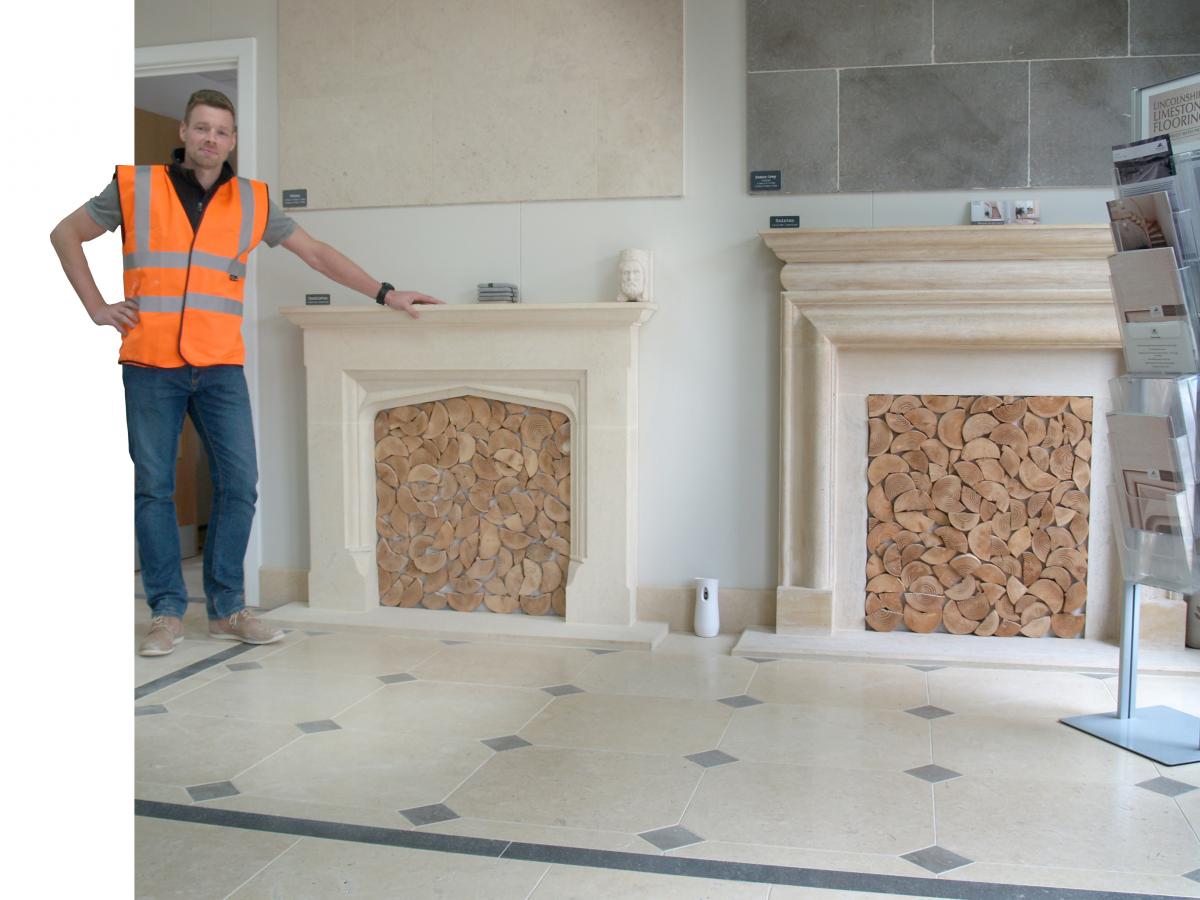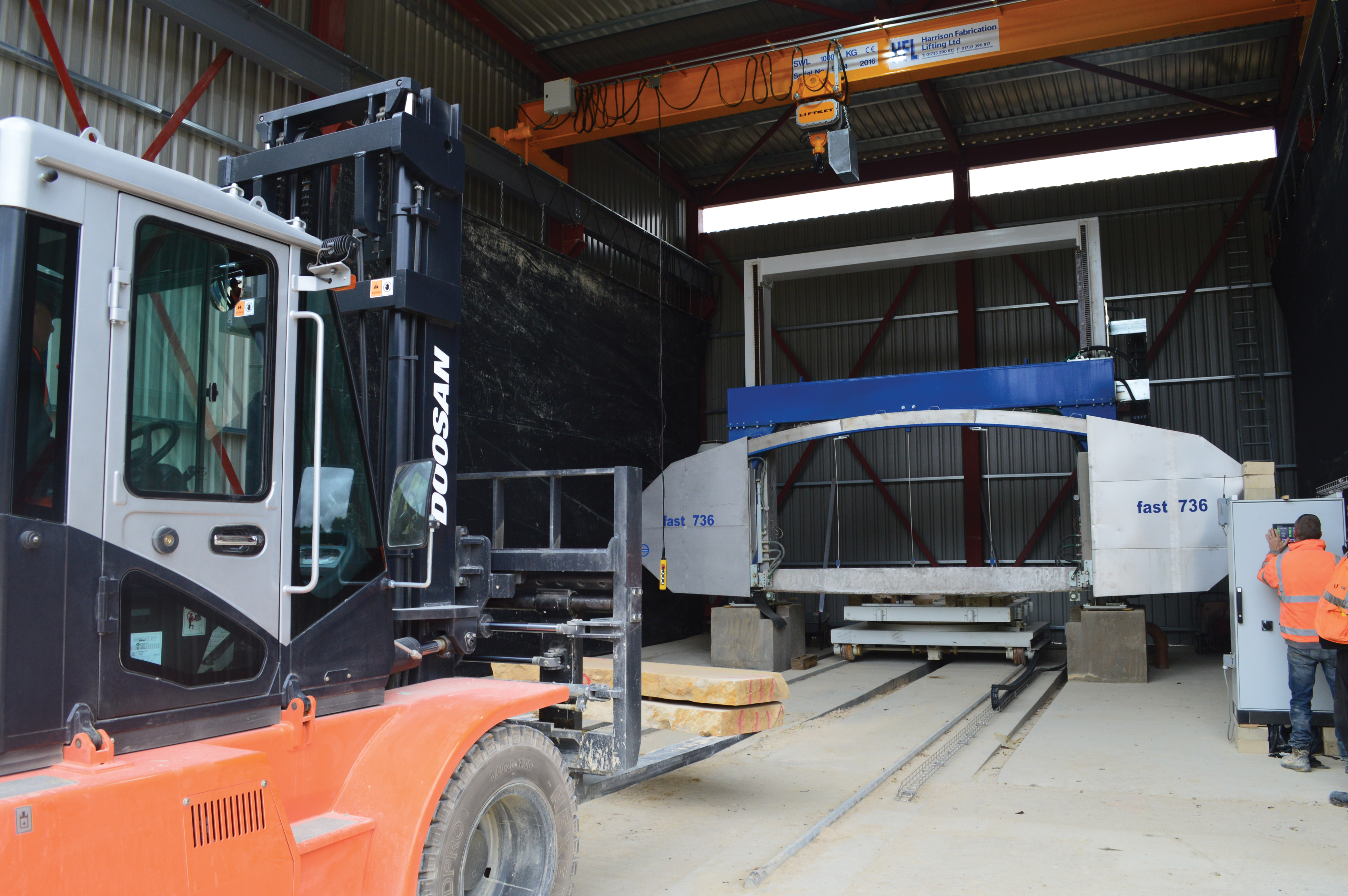Stone Supply : Stamford Stone Company
Stamford Stone in Rutland has invested a lot in new machinery in order to be able to give customers stone just how they want it. Just commissioned is a Benetti Fast that is cutting scants for masons who cannot easily accommodate blocks.
Not all the stonemasons Stamford Stone Company supplies want or have the equipment to handle the limestone block available from the company’s Medwells Quarry and Greetham Quarry. But they often don’t want finished product, either. So now Stamford Stone has bought a saw to cut the block into scants that masonry companies can handle more easily.
 The saw it has chosen is a Benetti Fast 736, which Director Daniel Wilson says certainly lives up to the promise of its name.
The saw it has chosen is a Benetti Fast 736, which Director Daniel Wilson says certainly lives up to the promise of its name.
The Italian saw is designed for cutting slabs and block trimming, which it does using a diamond belt that runs on a guiding blade, with water cooling and lubrication.
The belt is driven by two 1700mm pulleys powered by a 45kW inverter, allowing the belt speed to be infinitely adjusted according to the stone as well as reducing energy consumption.
It is computer-controlled for preset, continuous cutting with automatic hydraulic tensioning of the belt and hydraulic down feed, giving precise cuts while optimizing the belt’s life and performance. The 3m x 2.2m rotating block trolley can carry a load of up to 40 tonnes.
Daniel: “We are basically looking at promoting scanted Clipsham material to the smaller stonemasonry companies.” That is not to the exclusion of block – customers who still want block can have it. But now they have the choice.
When Daniel and his sister Laura took over running Stamford Stone in 2014, he identified a recurring problem in the stonemasonry market, firstly of unloading blocks of more than six tonnes – most of Clipsham blocks are 6-10 tonnes – and secondly of the quality of the material. Sawing the blocks into scants allows the stones to be checked for consistency before they leave Stamford Stone’s yard in the old Swaddywell Quarry.
“We don’t get many faulty Clipsham blocks due to its careful extraction using Fantini saws,” says Daniel, “but this is a more transparent way for both us and the masons – and, going forward, the client.”
When Daniel’s father, George Wilson, set up Stamford Stone with Ivor Crowson in 1997 it was because they had identified a need for building stone. They knew how difficult it was to obtain because they had first hand experience of that from their own developments.
They quickly established a significant customer base across a large section of the Midlands, and sometimes further afield including London.
As the business grew, they invested in infrastructure, machinery and transport, expanding the product offering all the time, both by working other stones and by cutting it into a broader range of building and landscaping products and masonry.
When Daniel came on to the Swaddywell Quarry site it was to establish his own business as Lincolnshire Limestone Flooring. He invested in a tiling line and also started supplying fireplaces, further expanding the product range available from Swaddywell Quarry.
Two years ago he opened a showroom and reception centre at the entrance to the Swaddywell Quarry site displaying flooring and fireplaces and expanding the range further with imported stones from Morocco and China. “It turned out to be good timing,” says Daniel. “We finished it just as things were picking up, which enabled us to hit the ground running. We had always said we were going to do it but had never got round to it. It has smartened up the whole place. It’s the best thing we ever did.”
Although the imported stones for interiors are new, importing is not new in itself to Stamford Stone. A visit to the Natural Stone Show in London when the company was first established saw it join the first wave of stone companies importing Indian hard landscaping, which it sold (and still does) as a complement to its Lincolnshire limestone walling.
Stamford Stone did not have some magic formula to avoid the downturn following the credit crunch, but it responded rapidly to the changes in 2008 that saw its core market of housebuilding halved.
Houses that were still being built in stone were at the highest echelon of the market, requiring more ashlar and architectural masonry and less walling stone. Stamford Stone refocused its attention on that end of the market, supplying the stone it required.
As the market has picked up in the past two or three years, more machinery – and more sophisticated machinery – has been bought by Stamford Stone, largely to keep up with the rapidly expanding demand.
The company bought a Donatoni tile and ashlar line, supplied by D Zambelis and incorporating a polisher that Stamford Stone already owned. It includes calibrating heads. A splitter with horizontal blades was added later to cut 53mm thick scants into two 25mm thick slabs. It was added to speed up the process – it saws limestone at a rate of 1.5m a minute.
Stamford Stone was going to buy an Omag CNC workcentre also sold by Zambelis in the UK, but it was (and still is) supplying Meister Masonry in Painswick, Gloucestershire, with its Clipsham from Medwells at that time. Meister has opened an extensive new factory equipped with (among other machines) a Marchetti workcentre. Richard Heather, the owner of Meister, said what a good machine the Marchetti was, so Daniel went to Italy to have a look. The Marchetti family took him round the marble quarries of Carrara to see their machinery working there. Daniel was convinced and bought an Axco with a lathe.
It was a similar story with the Benetti. Daniel had seen them working at Portland Stone Firms, where there are three of them. The reports were good, so, again, he went to Italy and bought one.
Stamford Stone are certainly not alone in investing in machinery in the past two or three years. Not too much machinery was bought for several years during the economic crisis, but eventually the industry realised it had to bite the bullet. The more companies that did so, the harder it became for other companies not to. “We were losing jobs because we weren’t competitive,” Daniel admits.
The new machinery has required new buildings to be erected at Swaddywell Quarry to house them, keeping everything clean and tidy in one of the neatest stone yards you will ever see.
Much of what Stamford Stone produces is still supplied to builders, although the company does also supply commercial projects, which this year have included four flights of stairs and 150m2 of flooring for Jesus College, Cambridge, and even the export of 700m2 of Clipsham from Medwells for a hotel in Dubai.
As well as the new machinery, there are two Gilbert saws that have been there since Stamford Stone first opened and continue to be exceptionally reliable, 3m and 2m Terzago primaries, a 1200mm Terzago Forma and 450mm GMM Axia. Croppers and tumblers produce walling. There are 38 people employed by the company, including seven in the quarries. The newest skill added is a draughtsman to provide the stone detailing to architects’ designs.
Stamford Stone is proud of what it has achieved and has had a whole series of successful open days to show off its site and quarries, attracting architects from as far away as London and Scotland. “It’s been a crazy couple of years,” says Daniel, “but it’s paying off.”

